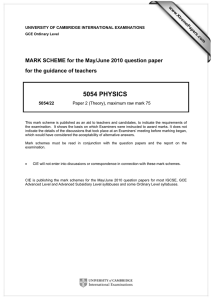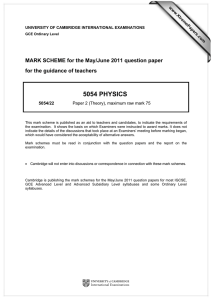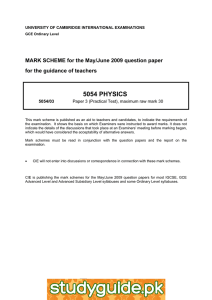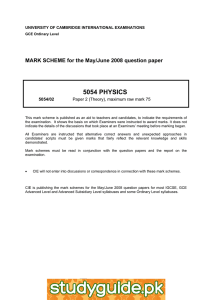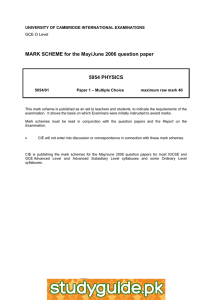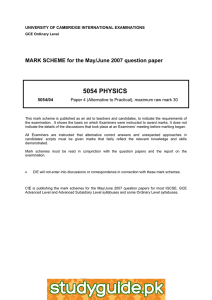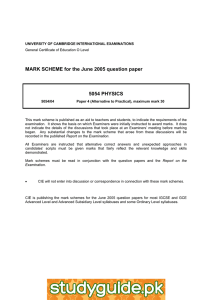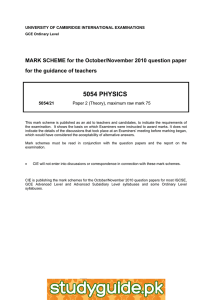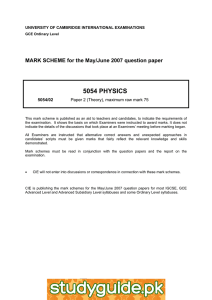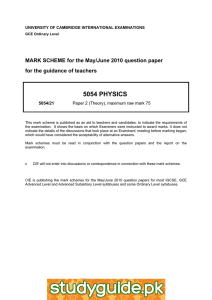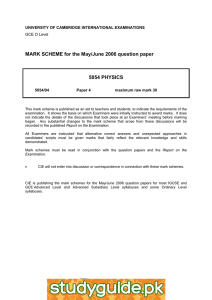5054 PHYSICS MARK SCHEME for the May/June 2010 question paper
advertisement
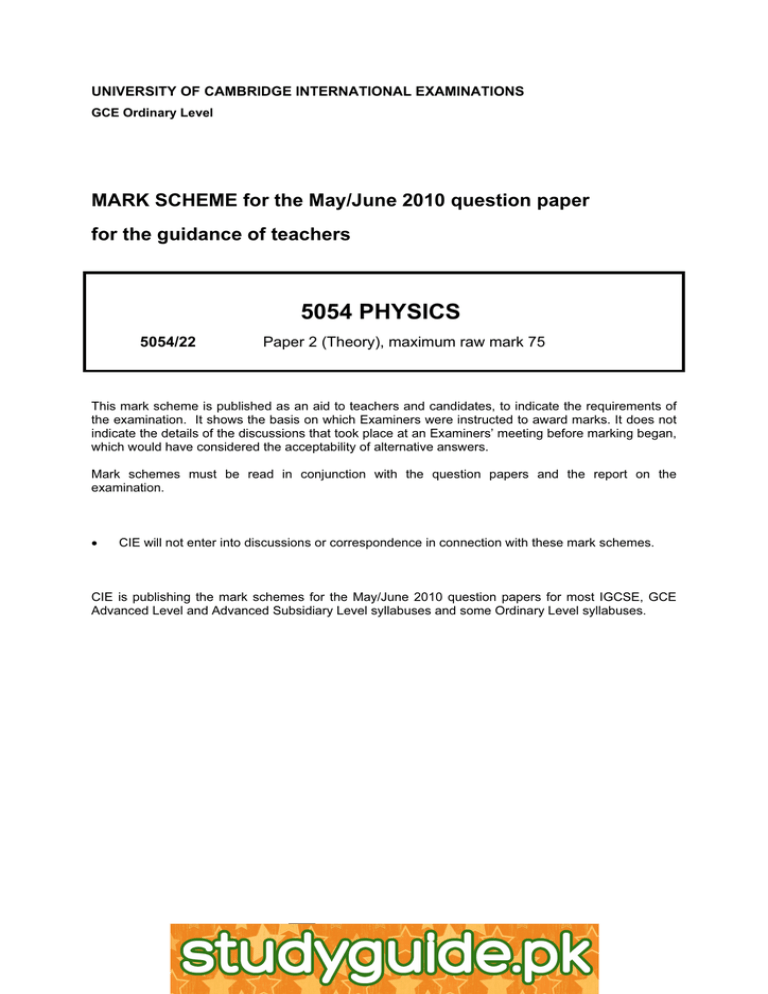
UNIVERSITY OF CAMBRIDGE INTERNATIONAL EXAMINATIONS GCE Ordinary Level MARK SCHEME for the May/June 2010 question paper for the guidance of teachers 5054 PHYSICS 5054/22 Paper 2 (Theory), maximum raw mark 75 This mark scheme is published as an aid to teachers and candidates, to indicate the requirements of the examination. It shows the basis on which Examiners were instructed to award marks. It does not indicate the details of the discussions that took place at an Examiners’ meeting before marking began, which would have considered the acceptability of alternative answers. Mark schemes must be read in conjunction with the question papers and the report on the examination. • CIE will not enter into discussions or correspondence in connection with these mark schemes. CIE is publishing the mark schemes for the May/June 2010 question papers for most IGCSE, GCE Advanced Level and Advanced Subsidiary Level syllabuses and some Ordinary Level syllabuses. www.XtremePapers.net Page 2 Mark Scheme: Teachers’ version GCE O LEVEL – May/June 2010 Syllabus 5054 Paper 22 Section A 1 (a) components shown on correct diagram with correct resultant (i.e. towards NE) and a scale given 540 (±10) m 22º ± 3° E of N with correct diagonal B1 B1 B1 [3] (b) idea that ends at start, returns in opposite direction B1 [1] [Total: 4] 2 (a) energy/time 1 joule in one second C1 A1 [2] (b) (i) 5800 N or 5684 N or 5700 N B1 [1] (ii) mgh algebraic, words or numerical (i.e. 580 ×10 × 12) 69 600 J or 70 000 J or 68 208 J or 68 000 J C1 A1 [2] (iii) (efficiency =) output power or energy/input power or energy algebraic or numerical or 93 000 seen or 4 640 seen 0.75 or 75% (accept 0.748) e.c.f. from (ii) C1 A1 [2] [Total: 7] 3 (a) (b) (c) radiation or infra-red or electromagnetic waves travels through space/vacuum or does not require medium/molecules/particles or medium required for conduction and/or convection or for other methods B1 B1 [2] conduction occurs or atoms/particles/molecules vibrate or electrons given energy heat/energy/vibration passed on from one particle to another or electrons move to other parts/diffuse/hit atoms B1 [2] (Q =) mcT algebraic or numerical in any form (e.g. 1.2 × 106 = m × 400 × 20) 150 kg C1 A1 [2] B1 [Total: 6] © UCLES 2010 www.XtremePapers.net Page 3 4 (a) (b) Mark Scheme: Teachers’ version GCE O LEVEL – May/June 2010 Syllabus 5054 Paper 22 increased/high(er) temperature/hot(ter) wind or air flow less humidity less pressure ANY 2 lines molecules/atoms/particles escape/leave (surface) or molecules become gaseous/vapour or molecules break bonds molecules with large(est) energy/high(est) speed sufficient or enough energy escape/break bonds/become gaseous or leave behind slow/less energetic molecules B2 [2] C1 A1 [2] [Total: 4] 5 (a) (i) smallest angle of incidence for total internal reflection or greatest angle of incidence that allows refraction or angle of incidence for (refracted) ray along surface/angle of refraction 90° B1 [1] (ii) correct angle marked to normal (by eye) B1 [1] (iii) ray along surface or reflected ray correct (by eye) or both rays B1 [1] (b) ray in air refracted away from normal B1 [1] (c) refractive index = sin i / sin r algebraic or numerical e.g. 1.5 = sin 50 / sin r C1 31° accept 30.71, 30.7 degree symbol required somewhere A1 [2] [Total: 6] 6 (a) (i) electrons B1 [1] (ii) neutralised/charge becomes zero/loses all charge/charge goes to earth electrons move to plane/tyres from ground/earth/zero potential/surface/land B1 B1 [2] (b) (otherwise) plane/tank/fuel becomes or is charged or charge builds up in some way or stays neutral/uncharged or (earthing) conducts charge away (to ground) avoids sparks or prevents explosion/fire/fuel igniting/blast or sparks/fires, etc. may be produced B1 B1 [2] [Total: 5] © UCLES 2010 www.XtremePapers.net Page 4 7 Mark Scheme: Teachers’ version GCE O LEVEL – May/June 2010 Syllabus 5054 Paper 22 (a) both arrows point inwards both arrows extended must pass through base of bar magnet N marked on both needles nearest S pole B1 B1 [2] (b) (current causes) coil/iron to become magnet/an electromagnet/creates magnetic field iron (in coil) attracts/pulls (pivoted) iron/armature (and L-shaped iron rotates/moves/turns) not contacts attract each other B1 (c) (i) resistance decreases B1 [1] (ii) series circuit/loop with C and lamp completely correct circuit with a battery C1 A1 [2] B1 [2] [Total: 7] 8 (a) (i) Geiger Muller/GM tube or any other gamma detector (ii) keep distance e.g. forceps/tongs barrier accept gloves, lead suit, metal container time of use accept use badge B1 [1] ANY ONE (iii) (with source) take a count for a time or take count rate (from a ratemeter/meter/count meter/counter) or read ratemeter (connected to GM tube) or record number of tracks (chamber) or count clicks in a time or note time when click occurs or several readings taken or readings fluctuate ignore readings random or time when click occurs varies (b) electromagnetic (wave/ray/particle) high frequency or small wavelength B1 [1] B1 B1 [2] B1 B1 [2] [Total: 6] © UCLES 2010 www.XtremePapers.net Page 5 Mark Scheme: Teachers’ version GCE O LEVEL – May/June 2010 Syllabus 5054 Paper 22 Section B 9 (a) (b) (c) (d) (e) (i) distance travelled while thinking/in reaction time or before braking starts B1 [1] (ii) distance travelled while brakes applied/car decelerates B1 [1] (i) speed (of cars) or same force/pressure on pedal or same braking force or same tyres or condition of brakes B1 [1] (ii) greater inertia/kinetic energy/momentum or smaller deceleration/acceleration B1 [1] any road condition, e.g. icy, wet, poor surface, slippery/smooth/rough surface and its correct effect on distance correct explanation that refers to friction e.g. more friction when dry B1 B1 [2] pressure low(er) (with larger area) B1 [1] (i) a = v/t any algebraic or numerical value e.g. 20/4; 20/3.4; 20/4.6; 20/0.6 5(.0) m/s2 C1 A1 [2] (ii) F = ma algebraic or numerical e.g. 900 × (i) 4500 N e.c.f. (i) C1 A1 [2] (iii) correct axes labelled with quantity and/or unit horizontal line at 20 m/s from 0 to 0.6 s straight line from end of horizontal section or from (0.6,20) to (4.6,0) or (4,0) B1 B1 B1 [3] (iv) area (under graph or of trapezium) B1 [1] [Total: 15] 10 (a) (b) how sound is made e.g. gun, clap hands, hit metal correct measurement of time, e.g. from seeing flash to hearing sound, clap-echo correct measurement of distance, e.g. gun to observer, observer to wall correct calculation for measurements, e.g. d / t or 2d / t precaution e.g. time clap on echo and time 10; ensure no wind; repeat in opposite direction; repeat and average; use large distance; use more than 200 m B1 B1 B1 B1 B1 [5] (i) (sound/wave/vibration) of high frequency or (sound that) cannot be heard (frequency) above 15–20 kHz C1 A1 [2] (ii) f = 1 / T or 6 × 10–6 (s) seen or 2,3,4 pulses in 12,18,24 µs 1.7 × 105 allow 166667 C1 A1 [2] © UCLES 2010 www.XtremePapers.net Page 6 Mark Scheme: Teachers’ version GCE O LEVEL – May/June 2010 Syllabus 5054 Paper 22 (iii) not all sound is reflected (from back surface) or some passes through the back (some energy/sound) absorbed (by metal) (sound/energy) spreads out/scattered/reflected in other directions/dispersed/ travels a (greater) distance any 2 lines B2 [2] (iv) at least one pulse half way between S and R in the long gap total height of pulse smaller than S and 3 or more drawn and labelled C B1 B1 [2] (v) v = fλ in any algebraic or numerical form e.g. 4000/8 × 106 5(.0) × 10–4 m C1 A1 [2] [Total: 15] 11 (a) circuit diagram with cell and ammeter in series with resistor/wire/lamp and voltmeter across resistor/wire/lamp R = V/I in any form or gradient of V, I graph thermometer/thermocouple used or shown statement of how different temperatures obtained, e.g. water bath/oven/heat room/change supply voltage or current or series resistor to change temperature (b) (c) B1 B1 B1 B1 [4] (i) resistance increases with temperature (approximately) linear, proportional, straight line increase M1 A1 [2] (ii) curved line starting at origin correct curvature from origin with decreasing gradient allow zero gradient not negative gradient C1 (i) 1 (current) increases thermistor resistance decreases B1 B1 [2] A1 [2] 2 (voltmeter reading) increases greater fraction of voltage across resistor or potential divider equation explained or greater current through fixed/constant/2000 Ω resistor (ii) (voltage across thermistor) 2.2 (V) or attempt to use potential divider formula (current) 3.8 / 2000 or 1.9 ×10–3 (A) or 3.8 = 6 × 2000 / (R+2000) or other correct potential divider equation 1200 Ω allow 1157 – 1160 B1 B1 [2] C1 C1 A1 [3] [Total: 15] © UCLES 2010 www.XtremePapers.net
